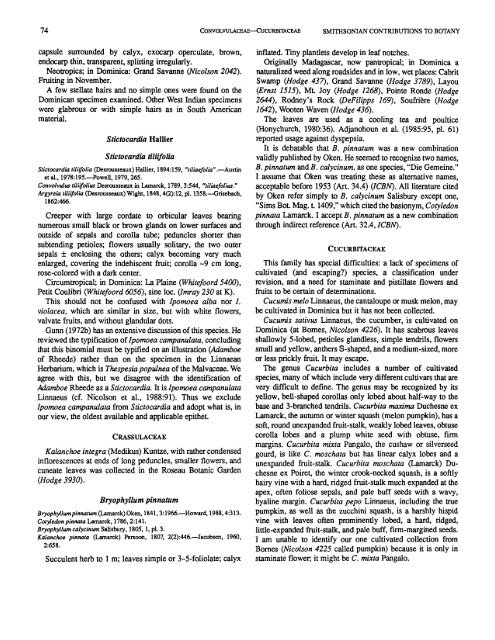Flora of Dominica, Part 2 - Smithsonian Institution Libraries
Flora of Dominica, Part 2 - Smithsonian Institution Libraries
Flora of Dominica, Part 2 - Smithsonian Institution Libraries
Create successful ePaper yourself
Turn your PDF publications into a flip-book with our unique Google optimized e-Paper software.
74 coNvoLwLAcEAE~cuRBmcEAE SMITHSONUN CONTRIBUTIONS TO BOTANY<br />
capsule surrounded by calyx, exocarp operculate, brown,<br />
endocarp thin, transparent, splitting irregularly.<br />
Neotropics; in <strong>Dominica</strong>: Grand Savanne (Nicolson 2042).<br />
Fruiting in November.<br />
A few stellate hairs and no simple ones were found on the<br />
<strong>Dominica</strong>n specimen examined. Other West Indian specimens<br />
were glabrous or with simple hairs as in South American<br />
material.<br />
Stictocardia Hallier<br />
Stictocardh tilufolia<br />
Stictocardia tiliifolia (Desrousseaux) Hallier, 1894:159, “tilhefolia”.-Austin<br />
et al., 1978:195.-Powell, 1979,265.<br />
Convolvulur tiliifoliur Desrousseaux in Larnarck, 1789,3544, “tiliaefOrius.”<br />
Argyreh tiliifolia @esrousseaux) Wight, 1848.4(2):12, pl. 1358.-Grisebach,<br />
1862466.<br />
Creeper with large cordate to orbicular leaves bearing<br />
numerous small black or brown glands on lower surfaces and<br />
outside <strong>of</strong> sepals and corolla tube; peduncles shorter than<br />
subtending petioles; flowers usually solitary, the two outer<br />
sepals & enclosing the others: calyx becoming very much<br />
enlarged, covering the indehiscent fruit; corolla -9 cm long,<br />
rose-colored with a dark center.<br />
Circumtropical; in <strong>Dominica</strong>: La Plaine (Whitefoord 5400),<br />
Petit Coulibri (Whitefoord 6056). sine loc. (Imray 230 at K).<br />
This should not be confused with Ipomoea alba nor I.<br />
violacea, which are similar in size, but with white flowers,<br />
valvate fruits, and without glandular dots.<br />
Gunn (1972b) has an extensive discussion <strong>of</strong> this species. He<br />
reviewed the typification <strong>of</strong> Ipomoea campanulata, concluding<br />
that this binomial must be typified on an illustration (Adamboe<br />
<strong>of</strong> Rheede) rather than on the specimen in the Linnaean<br />
Herbarium, which is Thespesia populnea <strong>of</strong> the Malvaceae. We<br />
agree with this, but we disagree with the identification <strong>of</strong><br />
Adamboe Rheede as a Stictocardia. It is Ipmoea campanulata<br />
Linnaeus (cf. Nicolson et al., 1988:91). Thus we exclude<br />
Ipomoea campanulata from Stictocardia and adopt what is, in<br />
our view, the oldest available and applicable epithet.<br />
CRASSULACEAE<br />
Kalanchoe integra (Medikus) Kuntze, with rather condensed<br />
inflorescences at ends <strong>of</strong> long peduncles, smaller flowers, and<br />
cuneate leaves was collected in the Roseau Botanic Garden<br />
(Hodge 3930).<br />
Bryophyllum pinnatum<br />
Bryophyllwnpinnatwn (Lamarck) Oken, 1841,3:1966.-Howard, 1988,4:313.<br />
Coiyledon pinnata Lamarck, 1786,2:141.<br />
Bryophyllwn calycinum Salisbury, 1805, 1, pl. 3.<br />
Kolanchoe pinnola (Lamarck) Persoon, 1807, 2(2):446.-Jacobsen, 1960,<br />
2658.<br />
Succulent herb to 1 m; leaves simple or 3-5-foliolate; calyx<br />
inflated. Tiny plantlets develop in leaf notches.<br />
Originally Madagascar, now pantropical; in <strong>Dominica</strong> a<br />
naturalized weed along roadsides and in low, wet places: Cabrit<br />
Swamp (Hodge 433, Grand Savanne (Hodge 3789), Layou<br />
(Ernst 1519, Mt. Joy (Hodge 1268), Pointe Ronde (Hodge<br />
2644). Rodney’s Rock (DeFilipps 169), SoufriZxe (Hodge<br />
1642), Wooten Waven (Hodge 436).<br />
The leaves are used as a cooling tea and poultice<br />
(Honychurch, 1980:36). Adjanohoun et al. (198595, pl. 61)<br />
reported usage against dyspepsia.<br />
It is debatable that B. pinnatum was a new combination<br />
validly published by Oken. He seemed to recognize two names,<br />
B. pinnatum and B. calycinum, as one species, “Die Gemeine.”<br />
I assume that Oken was treating these as alternative names,<br />
acceptable before 1953 (Art. 34.4) (ICBN). All literature cited<br />
by Oken refer simply to B. calycinum Salisbury except one,<br />
“Sims Bot. Mag. t. 1409,” which cited the basionym, Cotyledon<br />
pinnata Lamarck. I accept B. pinnatum as a new combination<br />
through indirect reference (Art. 32.4, ICBN).<br />
CUCURBITACEAE<br />
This family has special difficulties: a lack <strong>of</strong> specimens <strong>of</strong><br />
cultivated (and escaping?) species, a classification under<br />
revision, and a need for staminate and pistillate flowers and<br />
hits to be certain <strong>of</strong> determinations.<br />
Cucum‘s me10 Linnaeus, the cantaloupe or musk melon, may<br />
be cultivated in <strong>Dominica</strong> but it has not been collected.<br />
Cucum’s sativus Linnaeus, the cucumber, is cultivated on<br />
<strong>Dominica</strong> (at Bomes, Nicolson 4226). It has scabrous leaves<br />
shallowly Slobed, petioles glandless, simple tendrils, flowers<br />
small and yellow, anthers S-shaped, and a medium-sized, more<br />
or less prickly hit. It may escape.<br />
The genus Cucurbita includes a number <strong>of</strong> cultivated<br />
species, many <strong>of</strong> which include very different cultivars that are<br />
very difficult to define. The genus may be recognized by its<br />
yellow, bell-shaped corollas only lobed about half-way to the<br />
base and 3-branched tendrils. Cucurbita m‘ma Duchesne ex<br />
Lamarck, the autumn or winter squash (melon pumpkin), has a<br />
s<strong>of</strong>t, round unexpanded fruit-stalk, weakly lobed leaves, obtuse<br />
corolla lobes and a plump white seed with obtuse, firm<br />
margins. Cucurbita mixta Pangalo, the cushaw or silverseed<br />
gourd, is like C. moschata but has linear calyx lobes and a<br />
unexpanded hit-stalk. Cucurbita moschata (Lamarck) Duchesne<br />
ex Poiret, the winter crook-necked squash, is a s<strong>of</strong>tly<br />
hairy vine with a hard, ridged fruit-stalk much expanded at the<br />
apex, <strong>of</strong>ten foliose sepals, and pale buff s&ds with a wavy,<br />
hyaline margin. Cucurbita pep0 Linnaeus, including the true<br />
pumpkin, as well as the zucchini squash, is a harshly hispid<br />
vine with leaves <strong>of</strong>ten prominently lobed, a hard, ridged,<br />
little-expanded hit-stalk, and pale buff, firm-margined seeds.<br />
I am unable to identify our one cultivated collection from<br />
Bornes (Nicolson 4225 called pumpkin) because it is only in<br />
staminate flower; it might be C. mixta Pangalo.
















